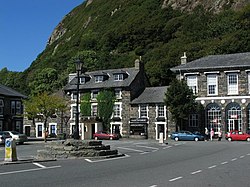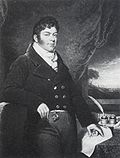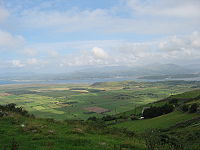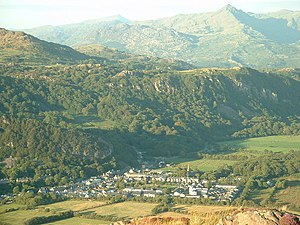Tremadog
| Tremadog | |
| Caernarfonshire | |
|---|---|
 The Square, Tremadog | |
| Location | |
| Grid reference: | SH562400 |
| Location: | 52°56’18"N, 4°8’27"W |
| Data | |
| Postcode: | LL49 |
| Local Government | |
| Council: | Gwynedd |
Tremadog (formerly Tremadoc) is a village on the outskirts of Porthmadog, in Caernarfonshire. It was a planned settlement, founded by William Madocks, who bought the land in 1798. The centre of Tremadog was complete by 1811 and remains substantially unaltered.
The village stands just north of Porthmadog and today is the smaller of the two, but Tremadog predates Porthmadog; the harbour around which the latter grew was created by the scouring out of the new channel by the River Glaslyn when diverted by William Madocks to reclaim Traeth Mawr and build his village.
Tremadog is a thriving Welsh speaking village, where the language is in everyday use. It hosted an unofficial Eisteddfod event in 1872.
Planning

By mid-1805, Madocks had already built some houses on the site of Tremadog, for he wrote to the Post-Master at Caernarfon informing him that letters addressed to Pentre-Gwaelod should be delivered to the new houses he had built on Treath Mawr, near Tan-yr-Allt. Pentre-Gwaelod translates as Bottom Village, but Madocks had grander plans, for aldermen and a mayor had been appointed, and he corrected the word "village" in a letter written soon afterwards to read "borough". He planned it himself, perhaps with some help from architectural friends and architectural books, but his letters reveal that a master plan was never produced, as he held the ideas for the settlement in his mind.[1]

To enhance the appearance of what could have been a flat and dull settlement, Madocks placed the Market Square, the centre of his project, just in front of a great crag of rock, which had formerly been the Caernarfonshire edge of the River Glaslyn estuary. It towers some 100 feet over the Town Hall and Dancing Room, and the coaching inn,[2] giving a theatrical effect to the area. He hoped to attract to the town others, who would then erect buildings that fitted his overall plan. Tremadog is a fine example of a planned town,[3] with an array of Georgian architecture built according to the classical traditions of the eighteenth century,[2] but he failed to entice many people to erect buildings, and eventually funded most of them himself.[4] The main streets were named Dublin Street and London Street, as Madocks wanted the town to be a stopping off point on the main route from London to Dublin. He was principally interested in what the town looked like, and keen that everything should enhance its appearance. He was less interested than many town planners of the time in the moral reform of those who lived there, believing that people had the right to work, educate their children, pray, drink, gamble, save or waste money as they saw fit. The town should provide its residents with opportunities to get on with their own lives, providing that they were congenial neighbours.[5]
The Town Hall or dancing room was situated at the head of the square, and was a large first-floor room. On the ground floor, five round arches supported the front of the building, and enabled the space to be used as a market hall. The dancing room had a fireplace at both ends, a minstrels' gallery on the back wall, and five large sash windows at the front, overlooking the square. Access to it was by stairs from the tap room in the adjacent public house, so that people attending a dance did not have to pass through the market area. The roof was in a similar style to many of Madocks' buildings, with a shallow pitch of slates, and wide eaves, while a flight of steps ran across the front of the building, creating a plinth on which it stood.[6]
During August, the market space became a theatre. The house to the east of the town hall was quite shallow, allowing a stage to be built behind it, connected to the market space by a proscenium arch. Madocks wrote several stirring prologues and a play for the theatre, and there are rumours that the playwright and poet Richard Brinsley Sheridan acted in a production of his own play The Rivals there, although it was probably his son Tom, who was a contemporary of Madocks.[7]
Church and chapel
Madocks believed that "in education and religion all ought to have fair play",[8] and this was reflected in the provision of a Gothic revival style church for the Anglicans and a classical chapel for the Methodists. Madocks mollified the Bishop of Bangor by telling him that the church would be built on rock, while the chapel would be built on sand, which Biblical allusion was true geologically.[9]
Industry
In the early 1800s, there was a thriving woollen industry, supplying garments to the southern states of America, the West Indies, South America, and Russia, but it was a cottage industry. One of Madocks' first projects was to build a manufactory to process wool on an industrial scale. The building was located close to his home at Tan-yr-Allt, because the high ground behind it provided a good head of water. It had a characteristic shallow-pitched slate roof, and Madocks instructed that the walls should be yellow, and the windows painted dark green. Nearby was a corn mill and a fulling mill. The water was provided by building a dam across a small valley, to form Llyn Cwm Bach, with sluices channelling the water to feed the mill and the factory.[10]
Although Madocks employed a Mr Fanshawe to manage the factory, he was not happy with his performance, and soon the project was being managed by John Williams, Madocks' assistant.[11] The building was advertised for sale in 1810,[12] and from 1835 was used as a tannery. It still stands, although is fitted with a temporary roof. In the 1990s, the Tremadog Buildings Preservation Trust obtained permission for its repair and conversion, but failed to acquire the site.[13]

Tourism
Tremadog is becoming an increasingly popular tourist destination. The area's long, quiet roads attract motorcyclists, and Tremadog also has two good quality rock climbing "crags" (one of which has been closed because of rock instability) which attract climbers from all over the UK. There have been issues with access to the crags, with local farmers and the Nature Conservancy Council trying to prevent climbing, but one section, Craig Bwlch y Moch, has been owned by the British Mountaineering Council since 1979. Deteriorating conditions led to annual events to tidy up the climbs between 2007 and 2010, and negotiations with the Forestry Commission resulted in invasive sycamore trees being removed in 2009.[14] A further event was held in April 2012,[15] but a climber was injured in May 2012 when huge blocks of rock were dislodged during a climb.[16]
See also
Outside links
| ("Wikimedia Commons" has material about Tremadog) |
References
- ↑ Beazley 1967, p. 82
- ↑ 2.0 2.1 Beazley 1967, p. 83
- ↑ CCT 2008, p. 5
- ↑ Beazley 1967, p. 85
- ↑ Beazley 1967, pp. 84–85
- ↑ Beazley 1967, p. 92
- ↑ Beazley 1967, p. 94
- ↑ CCT 2008, p. 6
- ↑ Beazley 1967, p. 97
- ↑ Beazley 1967, pp. 103–104
- ↑ Beazley 1967, p. 105
- ↑ Beazley 1967, p. 107
- ↑ CCT 2008, p. 3
- ↑ Kelly, Jim (21 June 2010). "Tremadog - a star is reborn". BMC. http://www.thebmc.co.uk/tremadog-a-star-is-reborn.
- ↑ Jones, Elfyn (26 April 2012). "Tremfest 2012". BMC. http://www.thebmc.co.uk/tremfest-2012-thank-you.
- ↑ Jones, Elfyn (20 May 2012). "Warning: rockfall at Tremadog". BMC. http://www.thebmc.co.uk/warning-rockfall-at-tremadog.
Books
- Beazley, Elisabeth (1967). Madocks and the Wonder of Wales. London: Faber and Faber.
- CCT (July 2008). Tremadog - Historic Planned Town. Cyfeillion Cadw Tremadog. http://tremadog.org.uk/content/55.php.
- Paget-Tomlinson, Edward (2006). The Illustrated History of Canal & River Navigations (3rd edition). Landmark Publishing. ISBN 1-84306-207-0.
